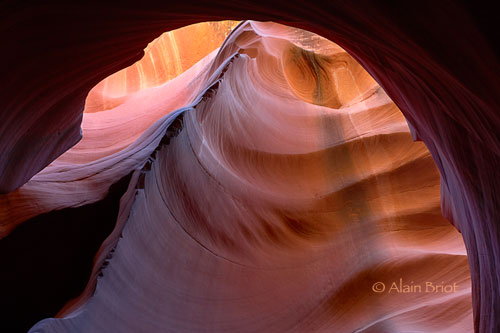
Antelope Canyon
Photography is best described as a two step process.
Step one is the creation of new images in the field.
Step two is the process of crafting a print that expresses what
we saw and felt.
The Photographers Digital Summit, now in its third year,
is a unique event in that it address both aspects of this two-part
process.
The Locations
The 2005 Digital Summit took place in Page, Arizona this November.
The creation of images in the field took place at several locations
near Page including Horseshoe Bend, Lake Powell and Antelope
Canyon. Antelope was our main location, given its significant
photographic potential.
The process of crafting a print that expresses what we saw and
felt in the field took place at the Page Marriott, a beautiful
adobe-style hotel with a great view of the surrounding landscape.
The Summit
The Summit is organized by Uwe Steinmueller and Alain
Briot. The great thing about having both of us work together
is that
our photographic styles are so different. This demonstrates
how two photographers can photograph the same subject at
the same time and yet get totally different images.
Why is that? For two reasons, reasons that are directly related
to the fact that photography is a two part process.
First, in the field we focus on different subjects. For example,
while I frequently use wide angles and relatively rarely telephotos,
Uwe hardly ever uses wide angles but uses telephotos a lot. Also,
Uwe likes to focus on details in the landscape, often cropping
out the sky, while I enjoy showing a lot more of the landscape
in my images and rarely crop out the sky, except when I shoot
down into a canyon or focus on small details.
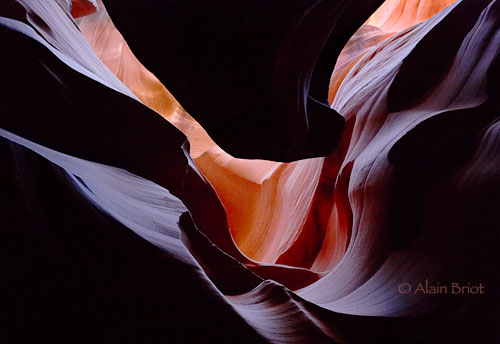
From Within the Darkest Recess
Second, in the digital darkroom we have different goals. For
example, I love color and like to create saturated images. Often,
for me, the success of a photograph hinges on being able to create
saturated colors while maintaining the believability of the image.
Uwe, on the other hand, prefers to use more subdued colors,
often creating images that are nearly monochromatic and yet are
not black and white. He also does not always set a true black
point in his images, explaining that what matters is whether
he likes the image or not, and not whether there is a true black
or not.
Finally, the southwest and the Page area are my home. I am intimately
familiar with this landscape and have worked with it for years.
For Uwe, this year’s Summit was very much the opportunity
to discover this landscape, with the surprises that comes with
it. For example, Uwe said during the Summit that he did not have
a palette for reds because in California one does not see a lot
of reds in the landscape, unlike in the Southwest where red is
found in nearly every cliff, canyon and sandstone outcrop.
Again, the concept that one needs a personal palette to render
a color to his liking demonstrates why the work of two photographers
working with the same subject is bound to be different. Clearly,
my palette for reds, and for other colors, is different from
Uwe’s palette for the same colors.
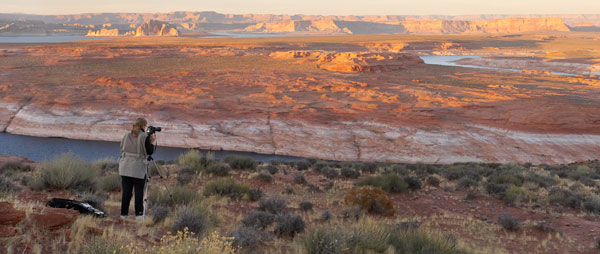 Photographing along Lake Powell at Sunset Photographing along Lake Powell at Sunset
And of course this brings up the question “do photographs
represent reality?” If one needs to find the proper palette
to express how he feels about the landscape, the answer is most
likely “no”. In my view, photographs represents not
reality as a whole, but rather our personal perception of reality,
a reality that will change according to our choice of palette,
as well as our choice of subject, composition and the many other
options that are available to us while optimizing an image and
working towards a fine print. It is this approach which leads
to developing a personal style.
In a sense this is what the Summit is all about: not only taking
good photographs and learning how to best optimize them in Photoshop
and other software, but also finding out how you see the world
around you and how you want to represent this world. It is about
finding out what is your reality, what is your personal style.
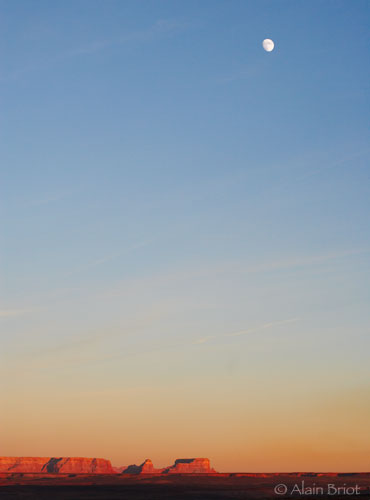
Moonrise at Sunset at Monument Valley
The Vision Field Workshops
The Vision Field Workshops were offered by Natalie and I over
two days after the Summit. During the Field Workshops we photographed
Monument Valley and Canyon de Chelly.
The Field workshops were designed to focus on personal style
and give each participant the chance to reflect on what characterizes
their personal style. In this sense they were a perfect continuation
to the Summit and nearly every Summit participant joined the
field workshops afterwards.
During the field workshop we focused upon personal style. I
was very impressed with how successful this process was. I had
not taught personal style in a short, two-day workshop before
and I thought that the results were fantastic. Natalie and I
were very impressed with the work of each participant and with
how seriously they completed the assignments were had prepared
for for them. Again, my congratulations to all the talented photographers
who participated in this event.
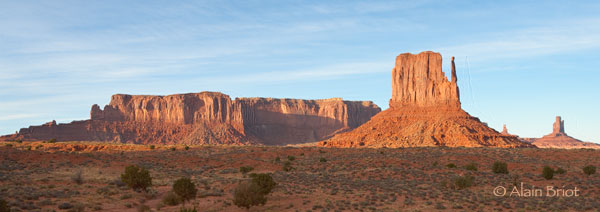 Monument Valley Monument Valley
If you like what we do during the Summit and if you want to
join us next year sent us an email to me.
We started preparing next year’s Summit, and even if it
will be a few months before it is announced, you can be among
the very first to know about it. The Summit will be in a new
location next year, and we are already talking about introducing
several exciting new features. Just like this year, it is bound
to become an event you will want to be part of.
You can see a collection of photographs created by Uwe during
the Summit in his Summit 2005 Diary.
Alain
For those of you who cannot wait Natalie and I are offering
a workshop to Antelope Canyon in April 2006.
|